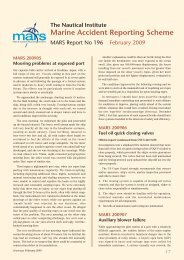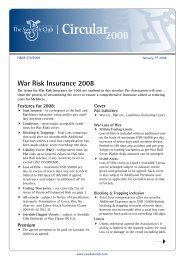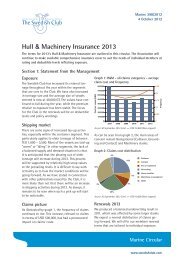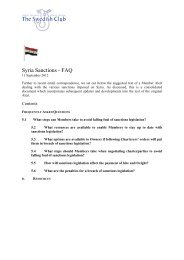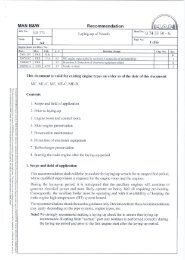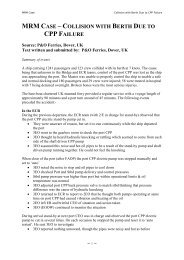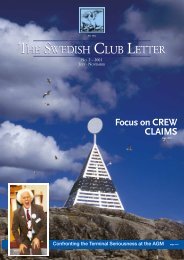List of Correspondents 2013 - The Swedish Club
List of Correspondents 2013 - The Swedish Club
List of Correspondents 2013 - The Swedish Club
Create successful ePaper yourself
Turn your PDF publications into a flip-book with our unique Google optimized e-Paper software.
Advice to Masters concerning H&M insurance<br />
Fire – CO 2<br />
CO 2 is an effective and clean way <strong>of</strong> fighting a fire. <strong>The</strong> gas works as an inhibitor and the oxygen<br />
in the atmosphere is replaced with CO 2. In order to be effective the compartment where the CO 2 is<br />
injected must be sealed gas tight. <strong>The</strong> CO 2 should be released in accordance with the instructions<br />
for your particular system which will indicate how many bottles or tanks are needed to reach the<br />
atmosphere necessary to suffocate the fire in each individual compartment.<br />
Even though it may be very difficult to extinguish a fire deeply seated in, for instance, cotton<br />
bales with CO 2, it may be possible to keep the fire under control and halt its spread into other<br />
cargoes or compartments until the vessel reaches port.<br />
A rule <strong>of</strong> thumb is that in order to achieve a 40% CO 2 atmosphere approximately 50 lbs. <strong>of</strong> CO 2<br />
for each 1000 cubic feet <strong>of</strong> air equal to 0,8 kgs CO 2 per cubic metre is needed. This will lower the<br />
oxygen content in the atmosphere to approximately 12.6% instead <strong>of</strong> the 20.8% which is the<br />
normal concentration.<br />
Consult your IMDG code and the emergency procedure supplement for information regarding any<br />
special arrangements necessary considering the type <strong>of</strong> cargo you are carrying.<br />
General average<br />
In order to protect your owners’ interests to the best <strong>of</strong> your ability we take the opportunity to<br />
touch upon the subject <strong>of</strong> general average (GA). <strong>The</strong> principles for GA have evolved from ancient<br />
times as means <strong>of</strong> compensating parties with a common interest in a maritime adventure. An act<br />
<strong>of</strong> general average is defined in the York-Antwerp Rules as:<br />
“<strong>The</strong>re is a general average act when, and only when, any extraordinary sacrifice or expenditure is<br />
intentionally and reasonably made or incurred for the common safety for the purpose <strong>of</strong><br />
preserving from peril the property involved in a common maritime adventure”.<br />
General average will normally be declared by owners who will appoint an average adjuster to<br />
collect all the facts surrounding the incident and also the average guarantees from the interested<br />
parties. It is imperative to ensure payment <strong>of</strong> cargoes’ contribution under the GA that the average<br />
guarantees (bonds) are collected before the cargo is released to the consignee.<br />
<strong>The</strong> average adjuster will in some instances appoint a special surveyor who will look upon damage<br />
and consequences <strong>of</strong> the casualty with the purpose <strong>of</strong> identifying those items which are GArelated<br />
damages.<br />
To better illustrate when there is a general average situation at hand we will list a number <strong>of</strong><br />
losses which may be considered as GA expenses and subsequently apportioned between the<br />
interested parties in the common adventure. <strong>The</strong> interested parties can be defined as the<br />
shipowner (the vessel), the time charterer (the bunkers), the cargo owners (cargo) and freight at<br />
risk (the shipowner).<br />
• Damage caused to vessel or cargo as a result <strong>of</strong> extinguishing a fire. For instance, cutting<br />
holes in bulk heads to access a fire or water damage to cargo when water has been used<br />
to extinguish the fire.<br />
<strong>The</strong> <strong>Swedish</strong> <strong>Club</strong> | 175



